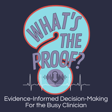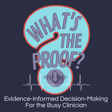
#11 Exercise is the Super-Pill We've Wanted All Along
In this episode of "What's the Proof?" we uncover why exercise truly is the miracle treatment we've been searching for. Exercise can drastically reduce the risk of heart disease, diabetes, cancer, dementia, and it has significant mortality benefits. Despite its profound impact, many physicians don't emphasize it enough in their practices. Join hosts Bobby, Dawn, and Sandy as they delve into the studies revealing the incredible health benefits of exercise and discuss practical ways to incorporate it into daily routines. Whether you're a clinician looking to motivate your patients or someone seeking to improve your own health, this episode is packed with valuable insights and evidence-based advice.
Episode Highlights:
[00:00] Introduction:
- Welcome and episode introduction by Bobby, Dawn, and Sandy.
- Discussion on the underutilization of exercise in medical practice despite its proven benefits.
[08:04] Exercise and the Effect on Major Diseases:
- Review of a 2013 BMJ study by on the dose-response relationship between physical activity and major disease risks.
- Explanation of MET minutes and their significance in quantifying physical activity levels.
- Discussion on how even moderate levels of physical activity can substantially reduce the risk of chronic diseases.
[12:02] Cardiorespiratory Fitness (CRF) and Mortality Risk:
- Overview of a 2018 JAMA study on CRF and all-cause mortality.
- Findings showing a strong linear inverse relationship between CRF levels and mortality rates.
- The importance of maintaining high fitness levels for reducing mortality risk.
- Insights on the impact of fitness at different periods of life, including midlife and later
[17:05] Strength Training Benefits:
- Analysis of a 2022 meta-analysis on muscle-strengthening activities and health outcomes.
- Discussion on the critical role of muscle strength in longevity and overall health.
- Practical advice for incorporating muscle-strengthening activities into daily routines.
[22:17] Practical Tips and Closing Remarks:
Episode Links:
- BMJ Study on Physical Activity
- JAMA Study on Cardiorespiratory Fitness
- CRF in Early Adulthood and Midlife
- Long-Term Change in CRF and Mortality
- Midlife CRF and Cancer Outcomes
- CRF and Dementia Benefits
- Br J Sports Med Strength Meta-Analysis
- Muscle Strength & Mortality
If you enjoyed this episode, please share it with your colleagues, friends, and patients! Subscribe here to "What's the Proof?" on YouTube for video content, and stay updated with the latest episodes! Share your thoughts and questions with us on Twitter @theproofpodcast or email us at whatstheproofpodcast@gmail.com.
Credits:
- Hosts: Bobby Scott, MD, FAAFP, DABFM; Sandy Robertson, PharmD; Dawn Caviness, MD, BSN, DABFM
- Production & Cover Art: Bobby Scott, MD, FAAFP, DABFM
- Music: Twisterium, MondayHopes, Muzaproduction, and SergeQuadrado from Pixabay

